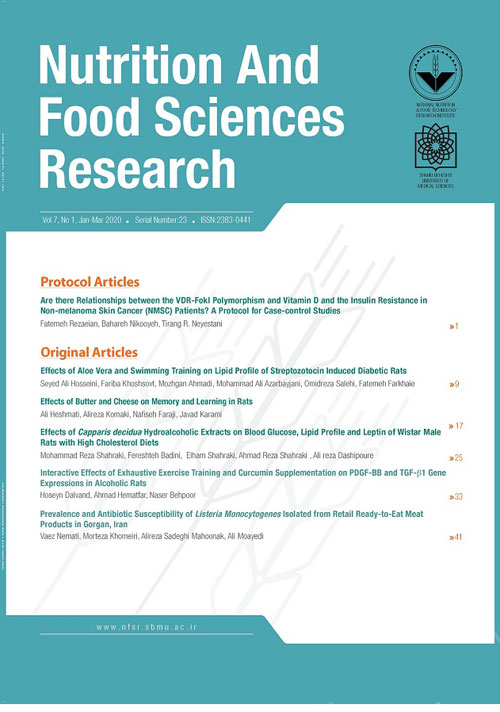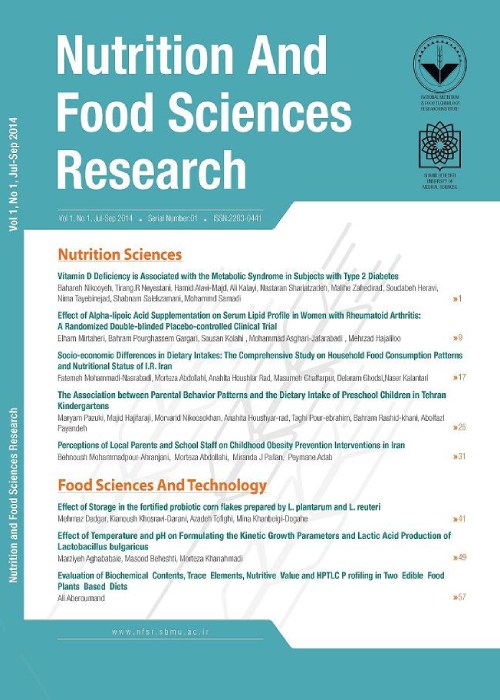فهرست مطالب

Nutrition & Food Technology Research
Volume:7 Issue: 1, Jan-Mar 2020
- تاریخ انتشار: 1398/11/10
- تعداد عناوین: 6
-
-
Pages 1-7Background and Objectives
Evidence indicate relationships between the sunlight exposure, vitamin D status and non-melanoma skin cancer (NMSC) risk. Vitamin D receptor (VDR) polymorphisms have been linked to metabolic changes in insulin resistance and various cancers. The purpose of this study is to investigate relationships between the sunlight exposure and the NMSC risk. Furthermore, relationships between the VDR FokI polymorphism and vitamin D status and the insulin resistance in NMSC patients will be assessed.
Materials and MethodsA hospital-based case-control study is designed. Participants are randomly categorized into case and control groups. Eligible patients are adults who meet the inclusion criteria with verified diagnosis of NMSC with signed informed consents. Totally, 73 NMSC diagnosed cases and 72 healthy controls are recruited and their sunlight exposure data and genetic information are collected via interviews and high-resolution melting (HRM), respectively.
ConclusionsThere are controversial reports on the relevance of sunlight exposure to non-melanoma skin cancer risk due to the dual effect of UVB radiation on promoting vitamin D3 synthesis in the skin and increasing DNA damage leading to skin cancer. Results of this study provide data on how much sunlight exposure includes beneficial health effects with no skin cancer risks. Vitamin D status may affect risks of insulin resistance-linked diseases such as cancers. Findings will contribute to the current knowledge of the roles of vitamin D, insulin resistance and FokI polymorphism in skin cancer development.
Keywords: Vitamin D, Insulin resistance, Non-melanoma skin cancer, FokI polymorphism -
Pages 9-16Background and Objectives
Exercise and nutrition are two effective factors in controlling diabetes-induced metabolic disorders. The aim of this study was to assess effects of aloe vera and swimming training on lipid profile of the diabetic rats.
Materials and MethodsIn this experimental study, 72 diabetic rats were selected and divided into nine groups of eight rats, including 1) four weeks of aloe vera consumption (FAV), 2) six weeks of aloe vera consumption (SAV), 3) four weeks of swimming (FS), 4) six weeks of swimming (SS), 5) four weeks of aloe vera consumption with swimming (FAVS), 6) six weeks of aloe vera consumption with swimming (SAVS), 7) Week-1 diabetic control (DC), 8) Week-4 diabetic control (FDC), and 9) Week-6 diabetic control (SDC). Groups 1, 2, 5 and 6 received 100 mg kg-1 of aloe vera daily. Furthermore, Groups 3 and 5 swam for four weeks and Groups 4 and 6 for six weeks, five sessions per week and 30 minutes each session. Data were analyzed using one-way ANOVA, two-way ANOVA and Bonferroni post-hoc tests (P≤0.05).
ResultsResults showed that training, aloe vera and aloe vera with training significantly decreased levels of triglyceride (TG), total cholesterol (TC), low density lipoprotein (LDL) and very low density lipoprotein (VLDL) (P≤0.05); four and six weeks of swimming trainings decreased TG, TC, LDL and VLDL (P≤0.05); and six weeks of aloe vera consumption decreased TG, TC, LDL and VLDL (P≤0.05).
ConclusionsFour and six weeks of aloe vera consumption and swimming training include interactive lipid lowering effects in streptozotocin induced diabetic rats.
Keywords: Training, Aloe vera, Diabetes, Lipid profile -
Pages 17-24Background and Objectives
Nutrition affects physical status, brain function, memory and learning. High-fat diets can cause memory impairment. The aim of this study was to investigate effects of cheese and butter on the memory and learning of male rats.
Materials and MethodsTotally, 24 Wistar male rats (8-week old) were divided into three equal groups and fed with high-fat chow diets (control group) or two experimental diets of butter and cheese for 12 weeks. Then, spatial memory and passive avoidance learning (PAL) were assessed using Morris water maze test and shuttle-box apparatus, respectively.
ResultsIn PAL test, step-through latencies in retention (STLr) test and time spent in the dark compartment (TDC) were significantly different between the groups. The step-through latencies in retention scores of the butter group were significantly lower than that of the control and cheese groups. However, dark compartment of the butter group was significantly greater than that of the control and cheese groups. In Morris water maze test, no significant differences were seen in escape latency, travelled distance and mean swimming speed of the various groups. During the probe trial, the butter groups spent significantly less time in the target quadrant than that the control and cheese groups did.
ConclusionsIn general, cheese includes further favourable effects on spatial memory and PAL, compared to that butter groups do.
Keywords: Cheese, Butter, Spatial memory, Learning, Memory -
Pages 25-31Background and Objectives
Capparis decidua is a plant used in herbal medicine. This study was carried out to assess effects of C. decidua hydroalcoholic extract on blood glucose, lipid profile and leptin in male rats with high-cholesterol diets.
Materials and MethodsTotally, 40 Wistar-albino male rats with 200–250 g weight were equally divided into one control (C) and three experimental groups of high-cholesterol diet (HCD), high-cholesterol diet and lovastatin (HCDL) and high-cholesterol diet and C. decidua hydroalcoholic extract (HCDCD). At the end of the intervention, animals were sacrificed using deep anesthesia. Blood samples were collected and fasting blood sugar (FBS), high density lipoprotein (HDL), total cholesterol (TC), triglycerides (TG) and leptin were assessed. Low density lipoprotein (LDL) was calculated using Friedewald formula. Results were expressed as mean ±SE (standard error). The P<0.05 was considered as statistically significant.
ResultsSerum TG in HCDCD group significantly decreased, compared to C and HCD groups (71.33±3.55 (mg dl-1) instead of 97.55±7.09 (mg dl-1) and 94 ±7.01(mg dl-1) respectively, P=0.003) and TC in HCDCD group significantly decreased, compared to HCD group (67.66±2.65 (mg dl-1) instead of 83.11±5.25 (mg dl-1), P=0.021). Moreover, TC in HCDL group significantly decreased, compared to HCD group (68.33 ±1.88 (mg dl-1) instead of 83.11 ±5.25 (mg dl-1), P = 0.04). Leptin included the lowest value in HCDL group, compared to other groups (P<0.0001). Other parameters did not include significant differences within the groups.
ConclusionsThe current findings have demonstrated that hydroalcoholic extracts from C. decidua leaves and thin stems decreased serum TG and TC in HCDCD male rats.
Keywords: Capparis decidua, High cholesterol diet, Lipid profile, Leptin, Wistar rat -
Pages 33-40Background and Objectives
Curcumin and exercise training are suggested to improve hepatic disorders. The aim of this study was to investigate effects of two weeks of swimming training and curcumin supplementation on platelet-derived growth factor (PDGF-BB) and transforming growth factor beta 1 (TGF-β1) gene expressions following ethanol consumption in Wistar male rats.
Materials and MethodsTotally, 32 Wistar male rats were divided into four equal groups, including control, exercise, curcumin and curcumin-exercise groups. Ethanol was gavaged to all groups (g kg-1) for four days. Then, the renunciation period (four days) started. The exercise period included two weeks, each week included five sessions of exhaustive swimming. Curcumin supplementation (50 mg kg-1) was used with trainings.
ResultsCurcumin supplementation demonstrated significant decreases in expression of PDGF-BB (P = 0.025) and TGF-β1 (P = 0.033) genes. In exercise groups, significant decreases were seen in expression of PDGF-BB (P = 0.007) and TGF-β1 (P = 0.001) genes. Interaction of exercise and curcumin resulted in significant decreases in expression of PDGF-BB (P = 0.040) and TGF-β1 (P = 0.013) genes.
ConclusionsIn conclusion, expression decreases in PDGF-BB and TGF-β1 genes suggest that exercise and curcumin consumption can protect hepatic tissues through controlling hepatic satellite cell (HSC) activation, preventing negative effects of ethanol.
Keywords: Curcumin, Exercise training, Ethanol, PDGF-BB, TGF-β1 -
Pages 41-46Background and Objectives
Listeria monocytogenes are known as an emerged foodborne pathogen and considered as a severe health risk. In the present study, prevalence and antibiotic resistance of L. monocytogenes isolated from ready-to-eat meat products in Iran were assessed.
Materials and MethodsA total of 200 ready-to-eat meat products, including chicken meat (wing, breast, and leg), lamb and fish, were collected, and L. monocytogenes was isolated according to ISO 11290–1. All of the isolates were verified using polymerase chain reaction and serotyping methods. Antibiotics susceptibility of L. monocytogenes isolates was assessed using the broth microdilution method.
ResultsThe presence of L. monocytogenes was verified in 13% of the samples. The presence of L. monocytogenes was reported in 26% of roast chicken meat, 5% of roast fish and 8.33% of cooked beef. Serology showed that Serotype 1/2a (48.13%) was the dominant serotype, followed by 4b (38.4%), 1/2c (6.99%) and 1/2b (6.48%). The result showed that 37 out of 100 L. monocytogenes isolates were resistant to all tested antibiotics. Furthermore, eight isolates were intermediately multi-resistant to the antibiotics. The rate of antibiotic resistance in L. monocytogenes was 52% in Serotype 1/2a, 39% in Serotype 4b, and 35% in Serotype 1/2c. Isolates of L. monocytogenes were mostly resistant to penicillin, ampicillin and erythromycin, but highly susceptible to tetracycline and gentamycin.
ConclusionsThe high level of L. monocytogenes prevalence and its resistance to antibacterial agents in meat products may result in severe human listeriosis. Therefore, it is necessary to use efficient monitoring protocols for antibiotic administration and further safety management systems in food production units.
Keywords: Listeria monocytogenes, Lamb, Chicken, Antibiotic, Fish


